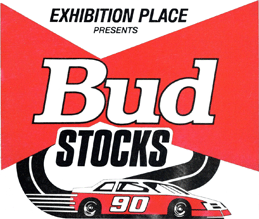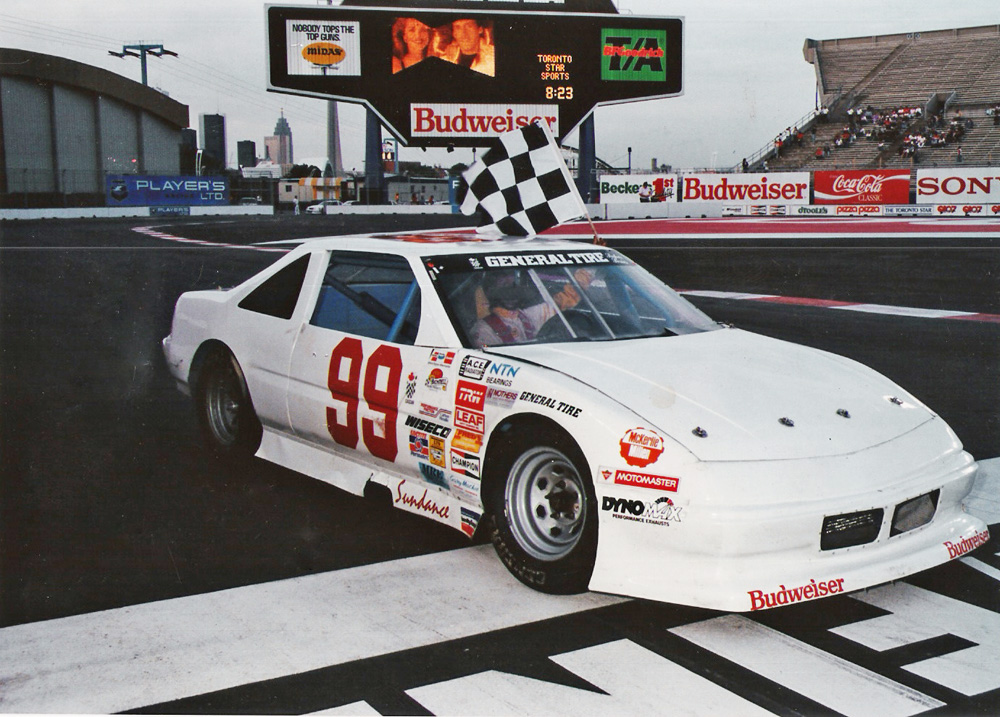 Can-Am Midgets - from the CAN-AM TQ Midget Racing Club History Facebook group
Can-Am Midgets - from the CAN-AM TQ Midget Racing Club History Facebook group
The classic
era of racing in Exhibition Stadium on the Canadian National Exhibition
grounds in Toronto began in 1952. Drivers like Ted Hogan, Norm Brioux,
Jimmy Howard, Harvey Lennox, Wallie Branston, Norm Lelliott, Howie
Scannell, Jack Cook and many others became local stars. Huge crowds
of up to 19,000 came to see these drivers rub fenders each week.
Unfortunately, the track closed at the end the of the 1966 season
to make way for a Centennial track-and-field meet.
The stock car racing did not return the next season and for the
next few years Exhibition Stadium was the home of the Toronto Argonauts
and later the Toronto Blue Jays. The only racing to be seen was
the annual Molson Supercross in the 1980s. In 1989 Skydome opened
and Exhibition Stadium sat unused as the Argos and Blue Jays moved
to the new stadium.
The City of Toronto and Exhibition Place Board of Governors looked
for something to fill the stadium once again. Racing seemed to be
the ticket. It made sense because all the required infrastructure was in
place. The only thing needed was the track itself. The facility
would be very unique in that it would have:
- a 17,000 seat, covered grandstand
- paved, well-lit pit area
- well-lit track surface
- large concession facilites
- large, modern washrooms (at least by race track standards)
- located in the middle of a city of over 2 million people
- large, instant replay scoreboard
- huge, paved parking area
- on public transit lines
It seemed like
a sure success. Well, read on and find out what really happened.

The City of Toronto approved a one-year program with conditions
for the second and third years. A telephone line was set up for
residents of Parkdale to make complaints (insert ominous music here).
About
$600,000 was spent preparing the facility. Because of the positioning
of the uncovered grandstands, the track was egg-shaped. Turns 1 and
2 were sweeping and turns 3 and 4 were very tight. The track
configuration of 1950s and 1960s was a traditional oval. The
original grandstand on the back straight was built for the
stadium's
reconfiguration to support football in 1959. This grandstand was
demolished and replaced in 1976, ready for the 1977 inaugral
Toronto Blue Jays season. It angled toward the covered grandstand
to support a baseball configuration, thus leading to the
egg-shaped track in 1990. The 1990 track was
1/3 mile long and 75 feet wide. It was completely flat, except for
a 3-inch elevation on the outside for drainage. Labatt was signed
on a sponsor and using their Budweiser brand name, the races became
known as the "Exhibition Place presents Bud Stocks". Other
sponsors were Player's Ltd, Chrysler Canada, Sony Canada, Becker's,
Coca-Cola and The Toronto Star.
Regular
racing featured CASCAR Late Models on Thursday nights and the Can-Am
Midgets and Hobby Club (now known as the Canadian Vintage Modifieds)
on Sunday afternoons. Regular admission was set at $8 for adults,
children under 12 were free. Special events included the CASCAR
General Tire Super Series on May 26 and back again on Oct 6. Also
scheduled were an Enduro (run to Delaware rules) on July 1, Monster
Trucks on September 2 and a demolition derby on August 26. The Pro-Four
class was added part way through the year. Also added later was
an American-Canadian Tour race.
It was originally announced that the races would run rain or shine
in the tradition of the earlier CNE racing. This proved to be unfeasible
with the state of race cars in 1990 and this idea was dropped before
the season started. One event did run in the rain though and that
was the Enduro. Being run under Delaware rules, the cars had to
have windshield wipers. The 250-lap Enduro was won by Ron Book.
The Enduro featured nineteen year-old Brad Corcoran who finished
in the top 5. Brad later moved up to Late Model and was Mosport
champion in 1999 and 2000.
The first CASCAR
General Tire Super Series event was on May 26, rained out from the
week earlier. A huge field of 53 cars showed up for the Budweiser
Triple 50's. Dan Shirtliff set the fastest qualifying time. The
cars were split into two semi-final 50 lap races with the top 12
cars from each moving on to the 50-lap final race. Don Mallat and
Rob Neely won the two semi-final races. In the 50-lap final race
Mallat and Jack Monaghan battled for the first 30 laps but Mallat
pulled away and led unchallenged to the end to take the win. Monaghan
finished second and Neely took third. There were about 2,500 fans
in attendance. The Super Series cars were posting mid 16 second
lap times.

The General Tire Super Series returned to the CNE on the weekend of October 5-6. Saturday saw the qualifying and heat races while the triple-50s were run on the Sunday. Rob Neely and Dan Shirtliff won the 50-lap semi-final races. Don Mallet took the lead on lap 5 of the 50-lap final and battled with Randy Latour for most of the race. Latour passed Mallet for the win on the back straight of the last lap when Mallet slowed to avoid Dave Whitlocks's hood that had come off his car. Mallet finished second and Rob Neely was third.
Jason Shaw dominated the Hobby Club by winning eight features and the points championship. Other feature winners in the Hobby class included Gary Elliott, Al Haringa Jr, Bruce Lindsay, Dave Bentley and Ray Hughes.
Feature winners
in Can-Am Midget included eventual points champion Dave McKnight,
Andy Mackereth, Ken Lorenz, Dave Balych, Arnie Bray, Norm Eberschlag,
Jim Johnstone and George Gilbert. Midget lap times were in the low
14 second range.
The CASCAR Late Models saw the appearance of some drivers who later
moved to the Super Series. Feature winners included points champion
Jason Latour, Dan Shirtliff, Howie Scannell Jr and others.
By all accounts, the racing was very good in all divisions. The
promoters did very little advertising though and as such, crowds
were very small. There were sometimes less than 1,000 fans in the
stands. Advertising was increased as the year went on and the crowds
got larger, ranging between 3,000 and 6,000 fans.
In the fall of 1990 plans were being made for the 1991 season but
there was trouble brewing. The races had lost money and some residents
of Parkdale had been complaining about the noise.
Some of the complaints seemed to stem from a bias against
racing rather than any reality. One complaint was the
increased traffic brought to the area. This argument
seems to lack merit, given that there
were only 3,000 - 6,000 fans there most nights and about
1,000 people at times. For years the Blue Jays had crowds
of 30,000 - 50,000 and no one complained about that
traffic. There were less than half as many race days
as there were baseball games as well. In the spring
of 1991 the City of Toronto refused to allow the races to continue
and stock car racing at the CNE was dead again.
Well, not quite dead yet. Racing at the CNE had one more fling in
August of 1997. You don't remember it? Of course not; no one knew
it was even happening. It was called "Extreme Motorsports"
and was scheduled to run each day of the 1997 Canadian National Exhibition.
There were to be Can-Am Midgets, Legends Cars, a vintage stock car
group, and a celebrity race using the Legends cars. The Midgets
pulled out citing the unsafe nature of the track preparation. There
was no advertising at all. The only mention of the event was a one
liner in the CNE visitor guide giving it the same coverage as fiddle
players and hog judging. Extreme Motorsports didn't even finish
the whole Ex - it was cancelled part way through. And then, stock
car racing at the CNE was truly dead. Exhibition Stadium was
demolished in 1999 and the site is now BMO Field, home of Toronto
FC.
